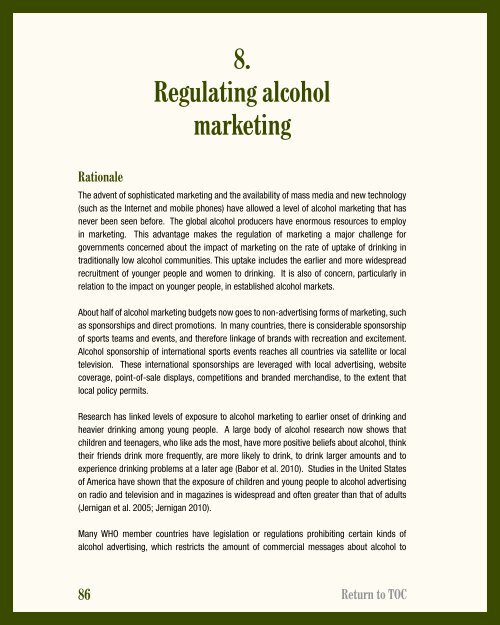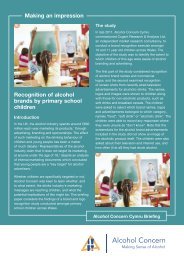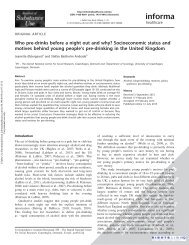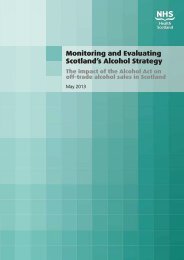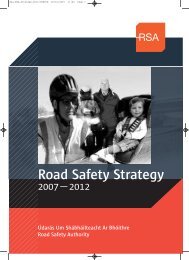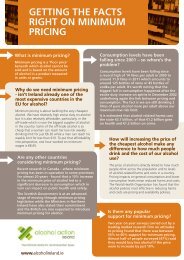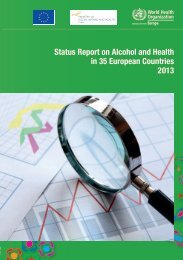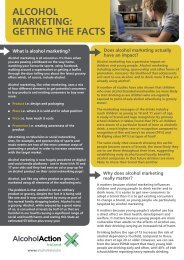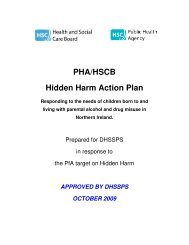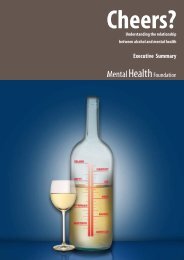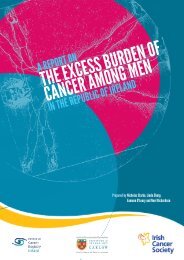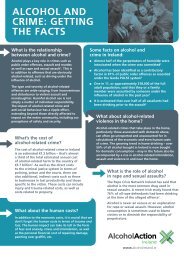Addressing the harmful use of alcohol - WHO Western Pacific Region
Addressing the harmful use of alcohol - WHO Western Pacific Region
Addressing the harmful use of alcohol - WHO Western Pacific Region
Create successful ePaper yourself
Turn your PDF publications into a flip-book with our unique Google optimized e-Paper software.
8.<br />
Regulating <strong>alcohol</strong><br />
marketing<br />
Rationale<br />
The advent <strong>of</strong> sophisticated marketing and <strong>the</strong> availability <strong>of</strong> mass media and new technology<br />
(such as <strong>the</strong> Internet and mobile phones) have allowed a level <strong>of</strong> <strong>alcohol</strong> marketing that has<br />
never been seen before. The global <strong>alcohol</strong> producers have enormous resources to employ<br />
in marketing. This advantage makes <strong>the</strong> regulation <strong>of</strong> marketing a major challenge for<br />
governments concerned about <strong>the</strong> impact <strong>of</strong> marketing on <strong>the</strong> rate <strong>of</strong> uptake <strong>of</strong> drinking in<br />
traditionally low <strong>alcohol</strong> communities. This uptake includes <strong>the</strong> earlier and more widespread<br />
recruitment <strong>of</strong> younger people and women to drinking. It is also <strong>of</strong> concern, particularly in<br />
relation to <strong>the</strong> impact on younger people, in established <strong>alcohol</strong> markets.<br />
About half <strong>of</strong> <strong>alcohol</strong> marketing budgets now goes to non-advertising forms <strong>of</strong> marketing, such<br />
as sponsorships and direct promotions. In many countries, <strong>the</strong>re is considerable sponsorship<br />
<strong>of</strong> sports teams and events, and <strong>the</strong>refore linkage <strong>of</strong> brands with recreation and excitement.<br />
Alcohol sponsorship <strong>of</strong> international sports events reaches all countries via satellite or local<br />
television. These international sponsorships are leveraged with local advertising, website<br />
coverage, point-<strong>of</strong>-sale displays, competitions and branded merchandise, to <strong>the</strong> extent that<br />
local policy permits.<br />
Research has linked levels <strong>of</strong> exposure to <strong>alcohol</strong> marketing to earlier onset <strong>of</strong> drinking and<br />
heavier drinking among young people. A large body <strong>of</strong> <strong>alcohol</strong> research now shows that<br />
children and teenagers, who like ads <strong>the</strong> most, have more positive beliefs about <strong>alcohol</strong>, think<br />
<strong>the</strong>ir friends drink more frequently, are more likely to drink, to drink larger amounts and to<br />
experience drinking problems at a later age (Babor et al. 2010). Studies in <strong>the</strong> United States<br />
<strong>of</strong> America have shown that <strong>the</strong> exposure <strong>of</strong> children and young people to <strong>alcohol</strong> advertising<br />
on radio and television and in magazines is widespread and <strong>of</strong>ten greater than that <strong>of</strong> adults<br />
(Jernigan et al. 2005; Jernigan 2010).<br />
Many <strong>WHO</strong> member countries have legislation or regulations prohibiting certain kinds <strong>of</strong><br />
<strong>alcohol</strong> advertising, which restricts <strong>the</strong> amount <strong>of</strong> commercial messages about <strong>alcohol</strong> to<br />
86 Return to TOC


